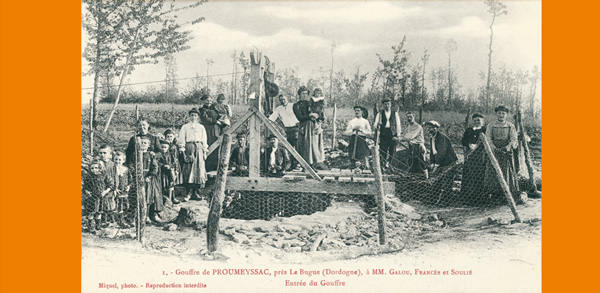There are some strange stories involving this cave, including a good number of legends, such as the one about the ducks. It is about a couple of ducks wearing a lovely ribbon around their necks which are said to have been thrown into the cave alive only to be found several days later on the Vézère river, swimming majestically no doubt, and quacking desperately in the vicinity of the fountain of Frémulot. To lend some credibility to this belief, another version tells that another pair of ducks, thrown into the hole, reappeared after some time with burnt wings, in Perdigat, in the town of St-Chamassy at the entrance of a small cave from which an abundant spring flows immediately into the Vézère.
Later on, stories also told of the petrifying basin into which young girls would throw a silver coin in the hopes of marrying within the year. Even today, dipping one's fingers in it is supposed to bring good fortune.

It seems that the earliest references to the existence of the cave date back to the beginning of the 18th century, at the time it was called "Trou de Promeissat" (or better yet "Cro ["Hole" in langue d'Oc] de Promeissat"). It was, at that time, considered to be the crater of an extinct volcano!
In 1755, a book entitled "l'Oryctologie" read as follows: "Near the place known as Drix, one and a half leagues from Bugue sur la Vézère, and four leagues from Sarlat, every now and then underground fires shoot up, burning any wood placed there. It's an actual volcano".
Today, that phenomenon can be explained by the condensation of the humid air that a cavity exhales into the cold air outside during winter. In this case we say that the cave is "smoking" not belching out flames! From smoke to fire and fire to a volcano, the popular imagination easily makes a connection, supported in this and even shaken by the local manifestations of the exceptional earthquake which took place in Lisbon on 1 November 1756, during which the Périgord felt terrible tremors in several locations: "Several lakes and fountains, including those in Marsac, went dry for several hours and the waters of the Ile* (now spelt "Isle"), a river which passes through Périgueux before flowing into the Dordogne in Libourne, violently agitated below Périgueux, swelled and flowed over into a small area. The river was nearly halted, as though divided in two, by the alternating tremors."
It is therefore not surprising to find the following description in the additive of Mr Desmaret's manuscript, attributed to the Canon of Chancelade, the late Mr Leydet, and dated 22 April 1765: "In the parish of Audrix close to the Vézère, there is a small volcano which can be seen belching small flames from time to time. When a stone is thrown into its mouth, the loud thud is echoed several times, which tells us that there is a very large and deep cavity that has been formed by previous losses. I do not know if earthquakes are more or less perceptible in the area surrounding this volcano".


